All gardeners have that day when they look at their garden and want something new to get their blood pumping again. It doesn’t matter that your neighbors still “ooh” and “aah” over it; for you, the spark is gone. If your garden has lost that certain something that used to make you sigh with admiration, it’s time to dust off those old, overused notions and go in search of new inspiration. You can find ideas at your local garden center, at a nearby botanical garden, or even in a friend’s garden. Whatever you do, don’t give up. Get mad, get frustrated, and then get busy. Start your wheels turning with these combos from gardens near and far. Alter them to make them your own, or flat-out copy them—no one will be the wiser.
Hostas aren’t the only shade lovers in town
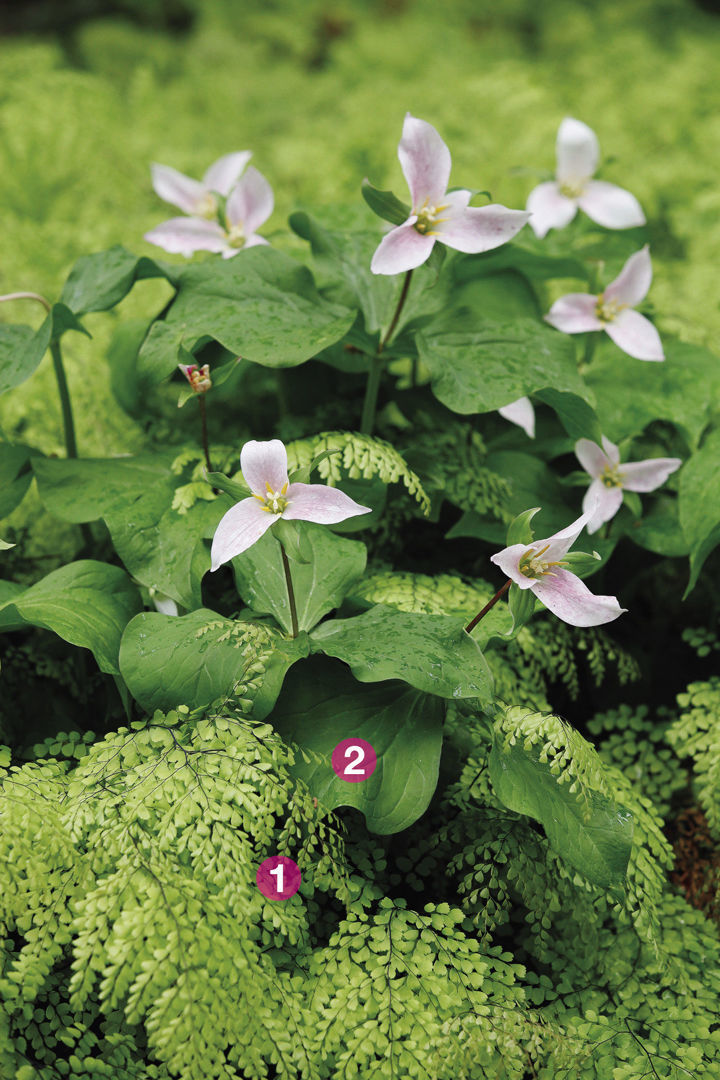
Sure, hostas are made for the shade—but they aren’t the only option. The delicate, feathery texture of maidenhair fern and the fragrant white petals of western trillium create a shade combo that won’t fade into the shadows. Plus, unlike colorful blooms that dull with age, those of western trillium have the unique quality of transitioning from white to pink as they mature.
1. Maidenhair fern (Adiantum sp., USDA Hardiness Zones 3–11)
2. Western trillium (Trillium ovatum, Zones 5–8)
Conditions: Partial to full shade; fertile, moist, well-drained soil
Designed by Norm Kalbfleisch and Neil Matteucci in Portland, Oregon • Photo by Joshua McCullough/www.phytophoto.com
Salad never looked so good

When it isn’t on your plate, lettuce makes a great foliage plant for combos in sunny spaces. The pansy’s vibrant blooms add color, while Mexican feather grass provides textural contrast and subtle movement on breezy days. Lettuce may require shading in high temperatures to prevent bolting.
1. Mexican feather grass (Stipa tenuissima, Zones 7–11)
2. ‘Oakleaf’ lettuce (Lactuca sativa ‘Oakleaf’, annual)
3. ‘Cimarron’ lettuce (Lactuca sativa ‘Cimarron’, annual)
4. ‘Lollo Rossa’ lettuce (Lactuca sativa ‘Lollo Rossa’, annual)
5. Matrix™ Deep Blue Blotch pansy (Viola × wittrockiana Matrix™ Deep Blue Blotch, annual)
Conditions: Full sun to partial shade; rich, moist, well-drained soil
Designed by the staff at Blithewold Mansion, Gardens & Arboretum in Bristol, Rhode Island • Photo by Danielle Sherry
Complementary colors aren’t just for art projects

Red and green. Is it the holidays already? No, but you don’t have to save this color combo for December. Red and green are complementary colors on the color wheel. That’s why this combo works so well. Whether you’re a pro or just a beginner, creating combos based on your art-class color wheel can be simple yet provide beautiful results.
1. ‘Oxford’ tulip (Tulipa ‘Oxford’, Zones 4–8)
2. ‘Purple and Gold’ euphorbia (Euphorbia characias ssp. wulfenii ‘Purple and Gold’, Zones 7–10)
3. ‘Queen of Sheba’ tulip (Tulipa ‘Queen of Sheba’, Zones 4–8)
Conditions: Full sun; moist, well-drained soil
Designed by Gina Price at Pettifers Garden in Banbury, Oxfordshire, England • Photo by Clive Nichols
Color makes the combo
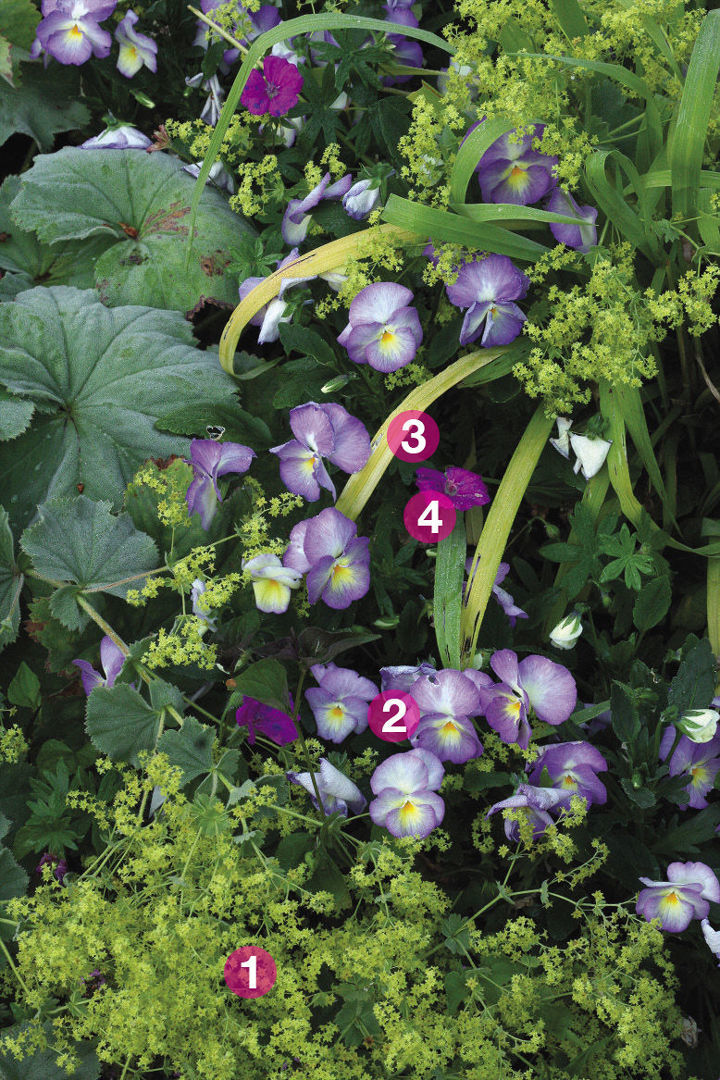
Whether subtle or bold, color plays an important role in design. The yellow highlights found in the otherwise dark blooms of ‘Etain’ violet make these flowers pop. Pair it with the golden blooms of lady’s mantle and the yellow blades of golden millet grass and you have one spectacular show. Once the blooms of ‘Etain’ violet and bloody cranesbill fade, the spectacular crimson fall foliage of bloody cranesbill takes center stage.
1. Lady’s mantle (Alchemilla mollis, Zones 4–7)
2. ‘Etain’ violet (Viola ‘Etain’, Zones 4–8)
3. Golden millet grass (Milium effusum ‘Aureum’, Zones 5–8)
4. Bloody cranesbill (Geranium sanguineum, Zones 3–8)
Conditions: Full sun to partial shade; rich, moist, well-drained soil
Designed by Sharon Nyenhuis for a garden in Port Angeles, Washington • Photo by Danielle Sherry
Contrasting texture turns a good combo great
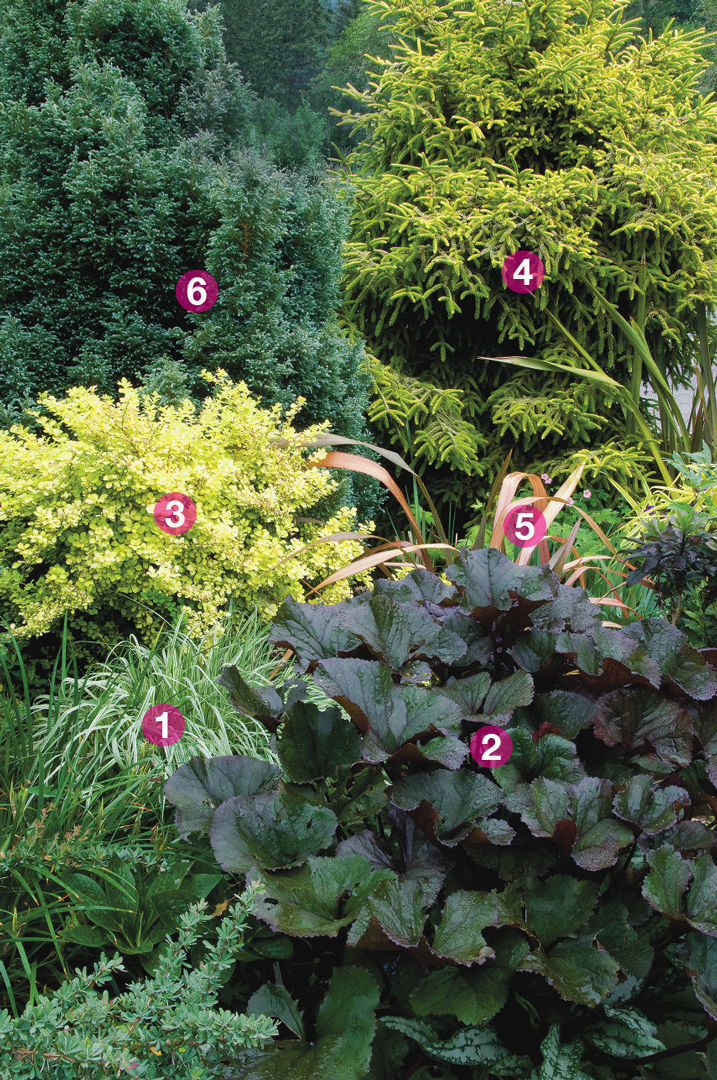
Texture might take a backseat to color for some gardeners, but this combo shows what you can accomplish when both design elements are put to work. Bright yellows, cool blues, glowing greens, and hints of maroon and orange provide just enough diversity to draw your eye. But once your attention is caught, what you really notice is the striking contrast in texture. Spiky blades of grass; rounded, veined leaves; and varying forms of evergreen boughs play off one another to create an awesome display.
1. Variegated moor grass (Molinia caerulea ‘Variegata’, Zones 5–9)
2. ‘Britt-Marie Crawford’ bigleaf ligularia (Ligularia dentata ‘Britt-Marie Crawford’, Zones 4–8)
3. Golden Japanese barberry (Berberis thunbergii* ‘Aurea’, Zones 5–8)
4. ‘Skylands’ Oriental spruce (Picea orientalis ‘Skylands’, Zones 5–8)
5. ‘Sundowner’ New Zealand flax (Phormium ‘Sundowner’, Zones 9–11)
6. ‘Devon Cream’ sawara cypress (Chamaecyparis pisifera ‘Devon Cream’, Zones 4–8)
Conditions: Full sun to partial shade; average to moist, well-drained soil
Designed by Cassandra and Brian Barrett for their garden in Dexter, Oregon • Photo by Allan Mandell
Colorful foliage won’t leave you longing for flowers
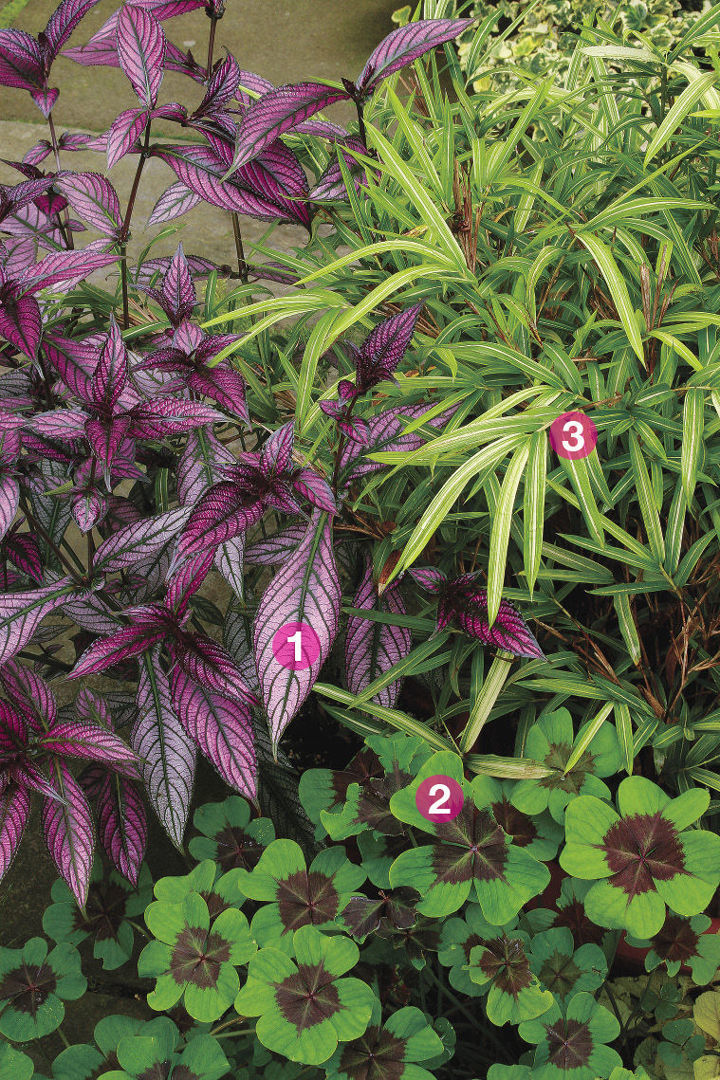
This foliage-first combo passes the test for reliable color and consistent performance. The vibrant purple tones of Persian shield are repeated in the center cross of oxalis, while the glowing white highlights of ‘Tsuboi’ bamboo add emphasis to these rich colors. Beautiful as it is in the ground, this combo is best suited for containers in warm climates where the bamboo can grow aggressively.
1. Persian shield (Strobilanthes dyerianus, Zones 9–11)
2. ‘Iron Cross’ oxalis (Oxalis tetraphylla ‘Iron Cross’, Zones 8–9)
3. ‘Tsuboi’ bamboo (Pleioblastus shibuyanus ‘Tsuboi’, Zones 7–11)
Conditions: Partial shade; moist, well-drained soil
Designed by Christian Primeau at Tower Hill Botanic Garden in Boylston, Massachusetts • Photo by Michelle Gervais
Light conditions aren’t always black and white
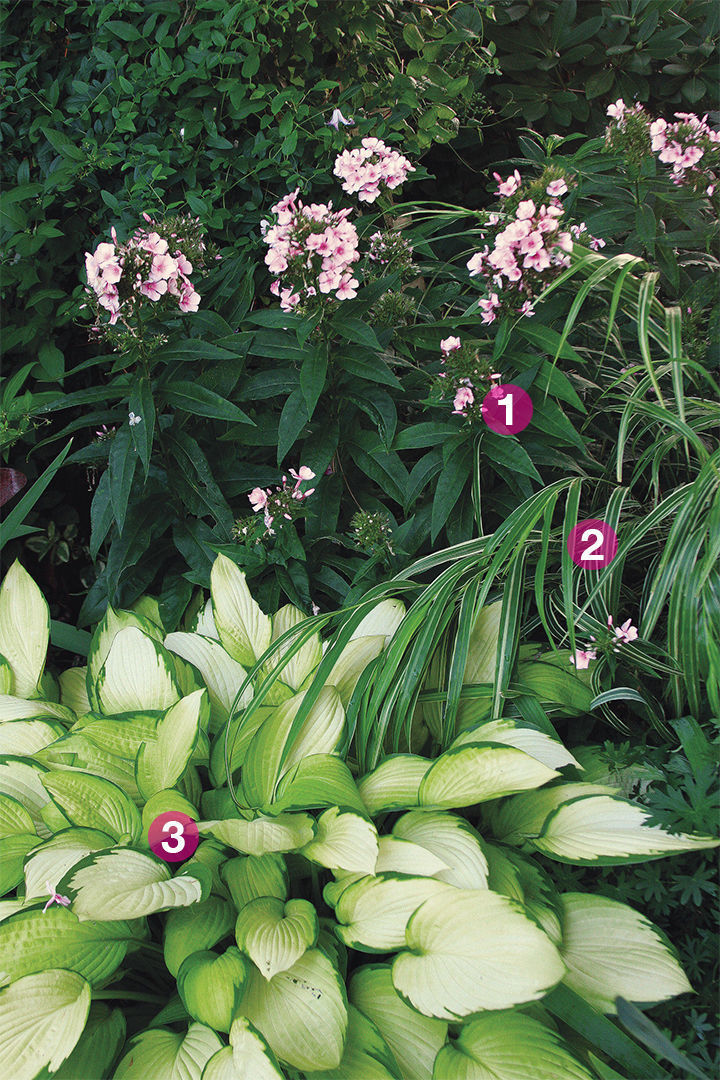
Sure, you’re nervous when it comes to shade. You panic about how many hours of light you get, and you go the safe route: Full-shade areas get only full-shade plants, and partial-shade areas get only partial-shade plants. But there are plenty of plants out there that are perfectly flexible and can provide a lot more options. Japanese forest grass, for example, likes shade but will tolerate sun. ‘Gold Standard’ hosta works well in a variety of shade conditions. ‘Bright Eyes’ phlox prefers sun but will still perform well in partial shade, though the blooms will be smaller. Put them all together in partial shade, as in this combo, and it’s a happy, dazzling combination.
1. ‘Bright Eyes’ phlox (Phlox paniculata ‘Bright Eyes’, Zones 4–8)
2. Japanese forest grass (Hakonechloa macra ‘Albo-striata’, Zones 5–9)
3.‘Gold Standard’ hosta (Hosta ‘Gold Standard’, Zones 3–9)
Conditions: Partial shade; average, moist, well-drained soil
Designed by Deanne Fortnam for her garden in Nashua, New Hampshire • Photo by Michelle Gervais
Green and more green isn’t always boring
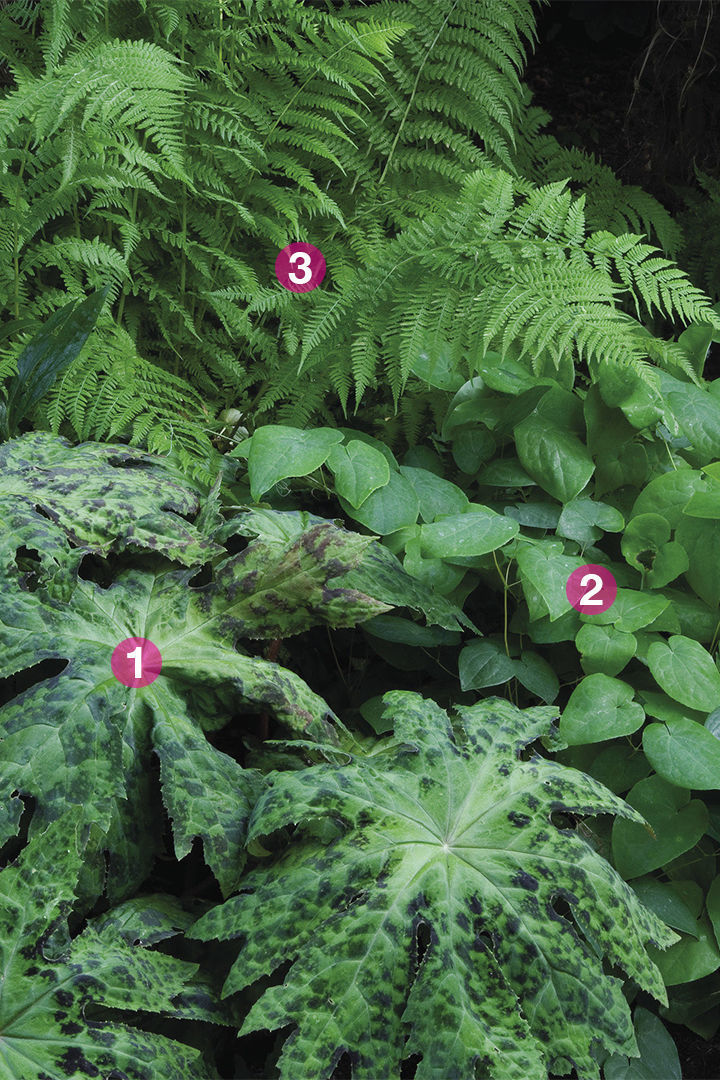
The natural, calming feel that you get from green plants doesn’t have to be so calm that it’s boring. Three green shade lovers, each unique in texture and shape, can make quite an impact throughout the season. This combo also provides an extra punch in spring, when Chinese mayapple and ‘Hot Lips’ epimedium produce blooms in shades of deep red and hot pink.
1. Chinese mayapple (Podophyllum delavayi, Zones 6–9)
2.‘Hot Lips’ epimedium (Epimedium ‘Hot Lips’, Zones 5–9)
3. Lady fern (Athyrium filix-femina, Zones 4–9)
Conditions: Partial to full shade; rich, moist, well-drained soil
Designed by Linda Cochran in Bainbridge Island, Washington • Photo by Allan Mandell
A combo never fails with coleus at its center
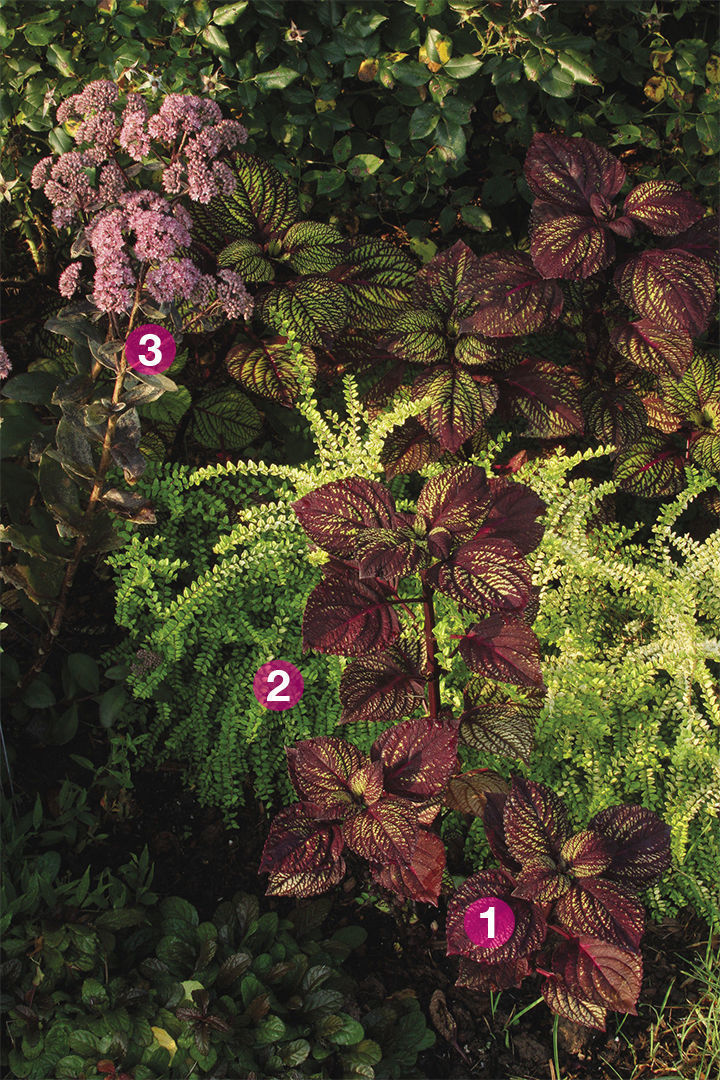
Coleus is one plant that was made for working in groups. The amazing range of color found in each leaf makes it simple to find matching candidates. Surrounded by plants with dark green foliage, the vibrant chartreuse flecks found in
‘Fishnet Stockings’ coleus shine even brighter paired with golden box honeysuckle.
1. ‘Fishnet Stockings’ coleus (Solenostemon scutellarioides ‘Fishnet Stockings’, Zone 11)
2. Golden box honeysuckle (Lonicera nitida ‘Baggesen’s Gold’, Zones 6–9)
3. ‘Matrona’ sedum (Sedum telephium ‘Matrona’, Zones 4–9)
Conditions: Full sun; average, well-drained soil
Designed by Jerry Fritz at Linden Hill Gardens in Ottsville, Pennsylvania • Photo by Michelle Gervais
Orange is for gardeners that like it hot

Some gardeners love cool colors: soft pastels or calm blues, greens, and purples. Other gardeners like it hot. For gardeners of this breed, you simply can’t go wrong with a mix of tropicals, annuals, and perennials in shades of deep orange that are almost hot enough to burn your green thumb. A focal point of Tropicanna® canna starts it off, while a few citron green foliage plants keep the flaming orange under control.
1. ‘Bonanza Flame’ French marigold (Tagetes patula ‘Bonanza Flame’, annual)
2. Tropicanna® canna (Canna indica ‘Phasion’, Zones 8–11)
3. King Tut® papyrus (Cyperus papyrus King Tut®, Zones 10–11)
4. Coleus (Solenostemon scutellarioides cv., Zone 11)
5. Illusion® Emerald Lace sweet potato vine (Ipomoea batatas ‘NCORNSP–012EMLC’, Zones 10–11)
Conditions: Full sun; average, moist, well-drained soil
Designed by Harold Taylor at Longwood Gardens in Kennett Square, Pennsylvania • Photo by Michelle Gervais
Sometimes a good garden combo calls for a stop sign
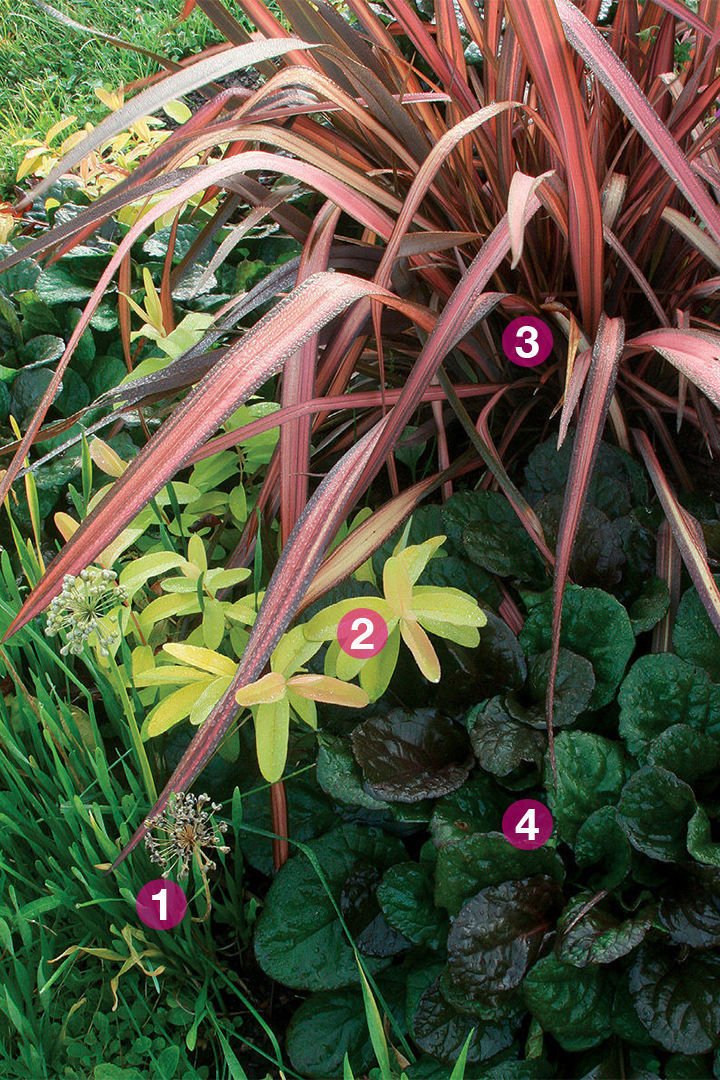
‘Flamingo’ New Zealand flax does for garden visitors what a stop sign does for traffic. In this combo, the plant’s bright color captures your attention from a distance. Approaching the plant, you start to notice the intricate details that surround it: the blooms of the circle onion; the multicolored, crinkly leaves of the bugleweed; and the vibrant foliage of the ‘Briggadoon’ St. John’s wort.
1. Circle onion (Allium senescens ssp. glaucum, Zones 4–10)
2. ‘Briggadoon’ St. John’s wort (Hypericum calycinum ‘Briggadoon’, Zones 5–9)
3. ‘Flamingo’ New Zealand flax (Phormium ‘Flamingo’, Zones 9–11)
4. ‘Catlin’s Giant’ bugleweed (Ajuga reptens* ‘Catlin’s Giant’, Zones 3–9)
Conditions: Full sun to partial shade; average, moist, well-drained soil
Designed by Nancy Ondra at Linden Hill Gardens in Ottsville, Pennsylvania • Photo by Michelle Gervais
Plants from the wild create natural elegance
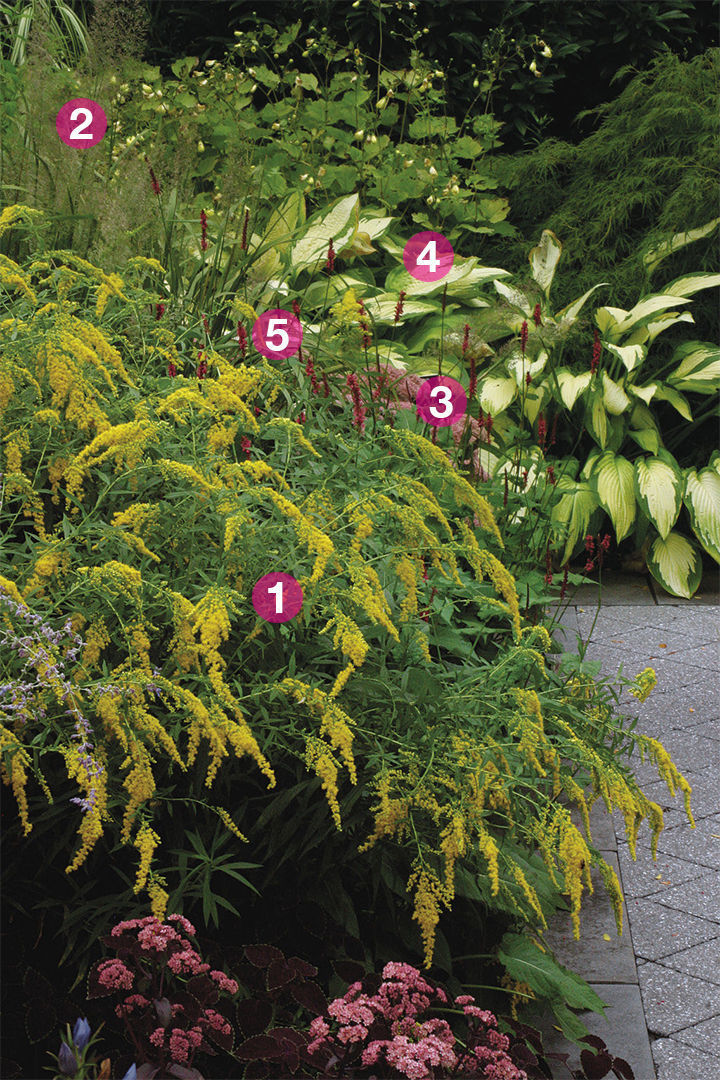
If “neat and tidy” doesn’t describe your gardening style, you’ll love the casual, tussled look of this combo. Goldenrod and grass give the illusion of a colorful windswept meadow. Splashes of pink and red add an ornamental feel to the group. Put it all together and you’re left with the appearance of natural, fuss-free elegance.
1. ‘Leraft’ goldenrod (Solidago ‘Leraft’, Zones 4–8)
2. Korean feather reed grass (Calamagrostis brachytricha, Zones 4–9)
3. ‘Xenox’ sedum (Sedum ‘Xenox’, Zones 3–9)
4. ‘Paul’s Glory’ hosta (Hosta ‘Paul’s Glory’, Zones 3–9)
5. Mountain fleeceflower (Persicaria amplexicaulis ‘Atrosanguinea’, Zones 3–8)
Conditions: Full sun to partial shade; average, well-drained soil
Designed by Lynden B. Miller at The New York Botanical Garden in Bronx, New York • Photo by Stephanie Fagan
Some combos get better once flowers fade
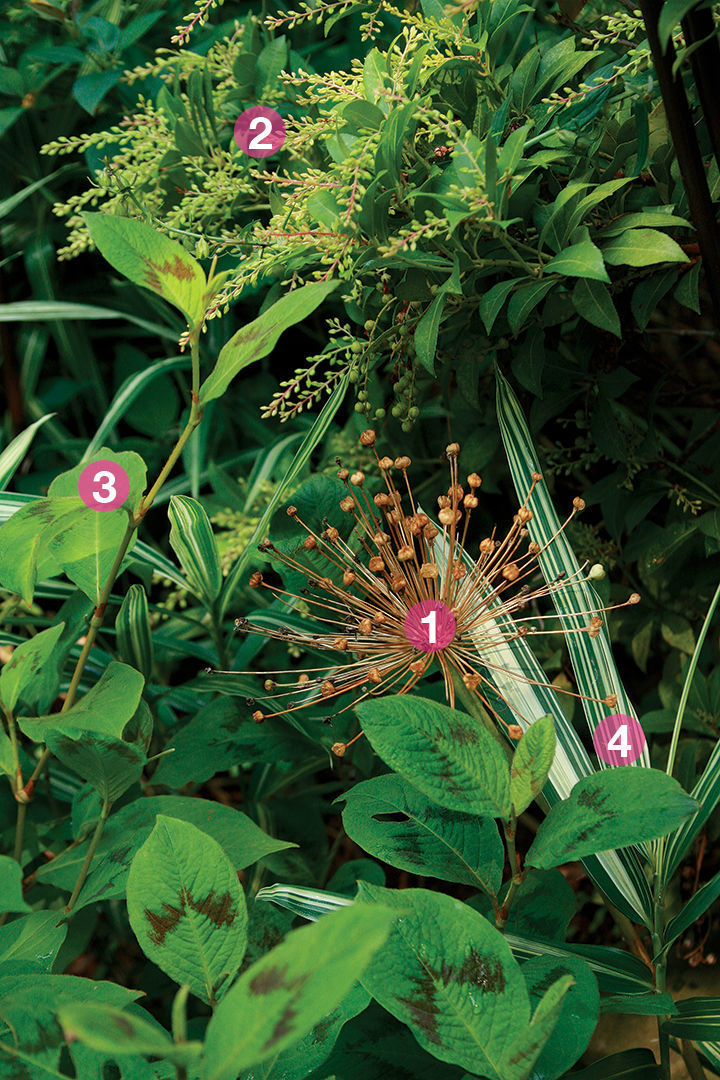
If you think flowers are what it’s all about, this combo will make you think again. The beige seed head of ornamental onion against the new pink-green buds of the pieris gives this combo an understated beauty after the blooms have faded. Hints of color in the leaves of the persicaria and the white variegation of dwarf whitestripe bamboo provide some additional yet subtle highlights to the group.
1. Ornamental onion (Allium schubertii, Zones 4–10)
2. ‘Valley Valentine’ pieris (Pieris japonica ‘Valley Valentine’, Zones 6–8)
3. ‘Lance Corporal’ persicaria (Persicaria virginiana ‘Lance Corporal’, Zones 5–9)
4. Dwarf whitestripe bamboo (Pleioblastus variegatus, Zones 6–11)
Conditions: Full sun to partial shade; average, well-drained soil
Designed by Mindy Arbo for her garden in Winchester, Massachusetts • Photo by Michelle Gervais
Contrast is the key
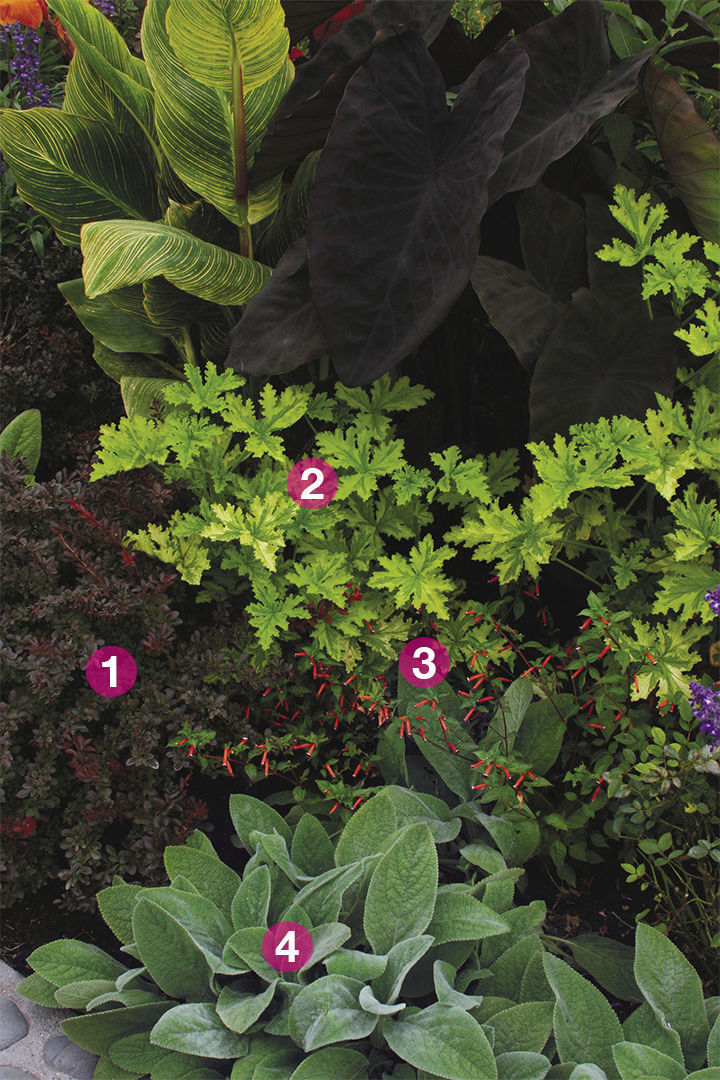
When you want something to stand out, use contrast. This combo’s mix of light and dark foliage creates a dramatic display. Best of all, this foliage will last throughout the season. Cigar plant adds a little oomph with its bright splash of flaming flowers.
1. ‘Concorde’ Japanese barberry (Berberis thunbergii* ‘Concorde’, Zones 5–8)
2. ‘Charity’ geranium (Pelargonium ‘Charity’, Zones 10–11)
3. Cigar plant (Cuphea ignea, Zones 10–11)
4. ‘Countess Helen von Stein’ lambs’ ears (Stachys byzantina ‘Countess Helen von Stein’, Zones 4–8)
Conditions: Full sun to partial shade; average to moist, well-drained soil
Designed by Barbara Weirich for her garden in Benton Harbor, Michigan • Photo by Danielle Sherry
Find balance to create a pleasing combo

Gardening is sometimes like gambling: You try different plants and combinations, hoping to hit the jackpot. Unlike gambling, however, you don’t always with with three cherries –or hostas– in a row. The key to designing a great garden combo is striking a balance between similar and dissimilar plant choices. If your selections are too simple, you’ll end up in snoozeville; if you strive for too much uniqueness, you’ll create a chaotic mess. You want to fall somewhere in the middle. It’s your choice how simple or unique to make you plant combination. Keep in mind, though, that the farther you go in one direction, the more likely it is that you’ll miss the mark and end up with either a boring scene ora chaotic one. Keep these ideas in mind when planning your combo, but don’t tip the scales too far in any particular direction:
- DO choose plants that have contrasting elements. Plants with the same texture and color blend together, creating little interest. Picture a lawn.
- DON’T pick plants with all contrasting but no common elements. Similar characteristics lead the eye from one plant to the next. If common links are no evident, chaos ensues.
- DO balance enough contrasting and common elements to establish a degree of harmony in your combo. You can control the amount of risk in your design by deciding how many similar and dissimilar characteristics to incorporate. Begin with color and texture; they are the easiest design elements to experiment with.
Brandi Spade is an associate editor.
Fine Gardening Recommended Products

The Regenerative Landscaper: Design and Build Landscapes That Repair the Environment
Fine Gardening receives a commission for items purchased through links on this site, including Amazon Associates and other affiliate advertising programs.

SHOWA Atlas 370B Nitrile Palm Coating Gloves, Black, Medium (Pack of 12 Pairs)
Fine Gardening receives a commission for items purchased through links on this site, including Amazon Associates and other affiliate advertising programs.







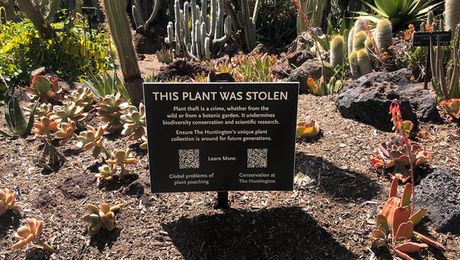











Comments
Log in or create an account to post a comment.
Sign up Log in